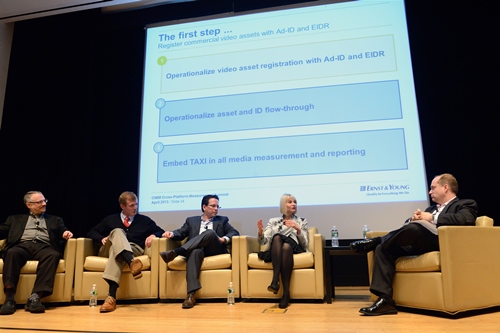CIMM-TAXI: The Roadmap for Marketing and Communication Interoperability - Harold S Geller

Last Thursday, I had the privilege of being on a panel called "YOUR TAXI IS WAITING: Implementing a UPC Code to Track Content and Ads Across Platforms" at the Second Annual Cross-Platform Video Measurement Summit, sponsored by the Coalition for Innovative Media Measurement (CIMM).
This panel discussed the final report of a two-year effort sponsored by CIMM, called Trackable Asset Cross-Platform Identification (TAXI). We will look back upon this report as the turning point in reducing cross-platform media complexity, and unleashing untold innovation for the benefit of marketers.
TAXI is an industry initiative to accelerate video asset identification and trackability standards across the media and entertainment supply chain, calling for all parts of the media ecosystem to coalesce around unique identifying codes provided by either Ad-ID, the industry standard for identifying advertising assets across all media platforms, or EIDR, a global registry for unique identification of movie and TV content.
The report stresses the importance of registering both advertising and entertainment assets, puts all the steps necessary to achieve marketing and communications interoperability in one location, and forms the framework for the standard-setting activities and process improvement conversations that must now take place. When fully deployed, these activities will not only deliver the measurement improvements CIMM initially set out to achieve, but will improve cross-platform supply chain efficiency and productivity. This will enable us to become more capable, as articulated in the ANA Marketers Constitution, tenets 5 and 6.
Participation in TAXI included unprecedented involvement of 28 M&E entities from media agencies, advertisers, measurement companies, media outlets, and other vendors. The conversations were enlightening, and illuminated the urgency of the foundational steps toward more timely and relevant measurement and management of cross-platform media campaigns.
The participants in TAXI also identified additional potential benefits of Ad-ID and EIDR adoption, including:
· Fewer barriers to deploying cross-platform dynamic ad insertion
- Improved measurement of the performance of ads
- More granular media ratings
- Improved automated content recognition
- Less complex second-screen integration
- Enablement of new anti-piracy tools and methods
- Reduced asset storage and transmission costs
The TAXI report articulates the three steps necessary to enable a projected $2 billion in annual M&E sector revenue and more than $500 million in M&E cost savings, and takes unnecessary and duplicative work out of the industry's workflow.
Step 1: Register all video assets with Ad-ID and EIDR registries. Fifty percent of TV ads and prerecorded episodic entertainment content is already registered, but there must be renewed attention to gain universal adoption.
The registration task for ads is generally the responsibility of the creative agency, and sometimes the advertiser. The combined advocacy of the media agencies and supply chain vendors (commercial distributors, production companies, and editing facilities), in addition to research vendors and the media, must be brought to bear to articulate the importance of this requirement, and the standardized process it affords.
It is important that the adoption of these standards take place no later than January 1, 2014, in line with previous calls from boards of both theANA and 4A's.
Step 2: Operationalize asset and ID flow-through. Detail functional requirements and budgets for implementing ID flow-through within media asset management, delivery, and distribution infrastructures.
This work will be led by Ad-ID, EIDR, and CIMM in conjunction with the Society of Motion Picture and Television Engineers, the Advanced Media Workflow Association, and other organizations, with broad cross-disciplinary involvement. These groups will provide regular progress updates to the industry stakeholders toward completion by the end of December 2014 as stated in the report.
Step 3: Embed TAXI in all media measurement and reporting.At the same time as the work in step 2 is taking place, media agencies and the media must make it a requirement that all internal and third-party measurement use Ad-ID and/or EIDR as a primary key. The ecosystem must drive ad delivery and content monetization business model transformation in ways not previously enabled before using unique identification.
SUMMARY
Why should anybody be concerned about a supply chain, workflow, or interoperability? Jack Myers recently wrote, "The future of technology is not the next new thing. Success in the future depends on understanding the new marketing, advertising, and media ecosystem that technology has created, its implications for your future, and how to most economically and effectively apply existing technologies to assure continued business success and revenue growth."
We have to keep paying focused attention to our ecosystem and interoperability. We can't allow our vendors to implement proprietary mechanisms. The TAXI report demonstrates the best practices that will allow us to navigate the increasingly complex multi-channel, multi-platform world of content monetization.
The full TAXI report can be accessed here, and a video featuring a variety of media and entertainment executives and brands discussing TAXI is here.

Panelists pictured above, from right to left: David Kohl, Advertising Lead, Media & Entertainment Advisory Practice, Ernst & Young, Janice Finkel-Greene, EVP / Buying Analytics, Magna Global, Bradley Epperson, VP, Commercial Operations, NBCUniversal, Mike Overly, Marketing Effectiveness Manager, LEGO, Harold Geller, Chief Growth Officer, Ad-ID
Photo: David Lubarsky Photography
The opinions and points of view expressed in this commentary are exclusively the views of the author and do not necessarily represent the views of MediaBizBloggers.com management or associated bloggers. MediaBizBloggers is an open thought leadership platform and readers may share their comments and opinions in response to all commentaries.

